Spider-view: Spider-Man/Dr. Strange: The Way to Dusty Death
This graphic novel pairs two unlikely heroes in a fun continuation of older continuity by a classic writer
—by Nathan on January 27, 2024—
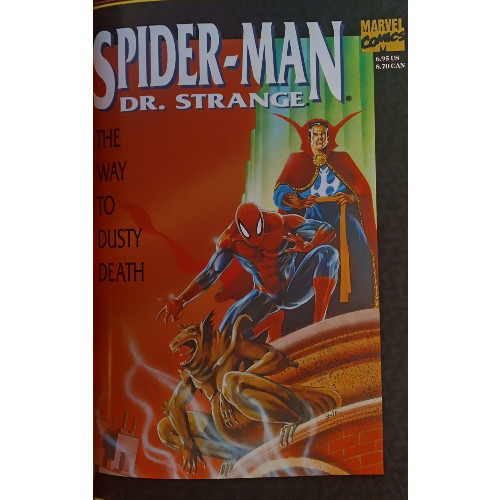
As I've discussed at length lately, Spidey often fights alongside (and, occasionally against) various heroes within Marvel's extensive superhuman pantheon. Many of these powered allies share characteristics with Peter, thus making their alliances logical. Spidey and Daredevil tend to face street-level crime and possess heightened senses; Spidey and the Human Torch are both young men each with similar life experiences and blessed with a healthy spirit of competition; Spidey and Iron Man are both big brained nerds and, for a while, worked together in a student/mentor relationship. Spidey teams with lesser known heroes or teams (like the New Warriors) from time-to-time, generally to give their titles a much needed shot in the arm from a beloved guest star.
Fans might then find Spidey's frequent pairings with Doctor Stephen Strange, the Marvel Universe's Sorcerer Supreme, a little, well, odd (see what I didn’t do there?). I mean, take a gander at his origin: once a brilliant surgeon, the good doctor soon dedicated his life to thwarting mystical threats to humanity's existence after encountering the Ancient One and learning the ways of magic. Not many similarities to our wall-crawling buddy, is there? Perhaps their biggest connection is that each hero was co-created by legendary artist Steve Ditko, which I would credit as a reason behind the pair's first meeting in Amazing Spider-Man Annual #2; heck, the comic itself makes a comment about this, saying "the fact that he [Ditko] also draws Doc Strange may have had something to do" with the heroes' first official meet-up.
Regardless of their dissimilarities, both Spidey and Strange have had several meetings over the years, and The Way to Dusty Death feels like a culmination of those interactions. Carrying an "It's all been building to this" vibe, the graphic novel tackles a few older story threads and ties them together.
Let's take a look and see if we get ourselves a nice little bow or one big knot.
Spider-Man/Dr. Strange: The Way to Dusty Death
Writer: Roy Thomas (co-plotter/scripter), Gerry Conway (co-plotter)
Penciler: Michael Blair
Inkers: Mark Beachum, Mark Texeira, Michael Blair
Colorist: Bob Sharen
Letterer: Joe Rosen, Rick Parker
Issues: Spider-Man/Dr. Strange: The Way to Dusty Death Original Graphic Novel (OGN)
Publication Date: August 1992
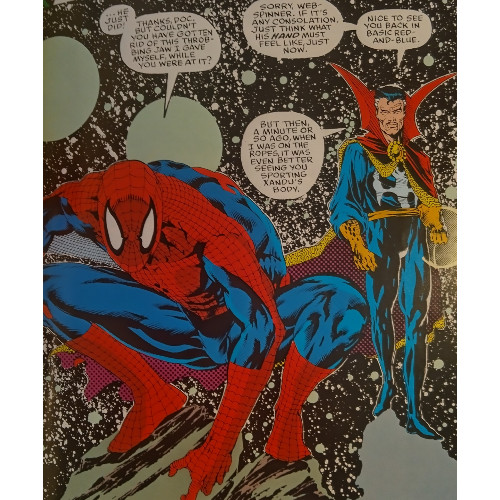
The Way to Dusty Death is a narrative that has, unknowingly, been building for years. First teaming in the aforementioned ASM Annual #2, Spidey and Doctor Strange went toe-to-toe (and magic spell-to-magic spell) against the wizard Xandu, who sought out the mystical Wand of Watoomb, which allowed the user not only great power but the ability to create dimensional rifts. Defeating him, Spidey and Strange faced Xandu once more, in Marvel Team-Up #21, and Spidey later battled the wizard alongside the Scarlet Witch in Marvel Fanfare #6. Each time, the reader believed Xandu defeated and the Wand safely removed from his grasp.
The basic plots—Spidey and Strange team up to fight Xandu and keep him from using the power of the Wand—felt a little circular by the third story, but fortunately, Xandu's backstory evolved with each appearance. At first thought to be just a power-hungry madman, Xandu revealed his intentions were to save his beloved Melinda, whom he accidentally placed into a sleep-like death. Marvel Fanfare #6 ended with Xandu again defeated, and Melinda returned to human form, alive while Xandu languished in the so-called "Death Dimension."
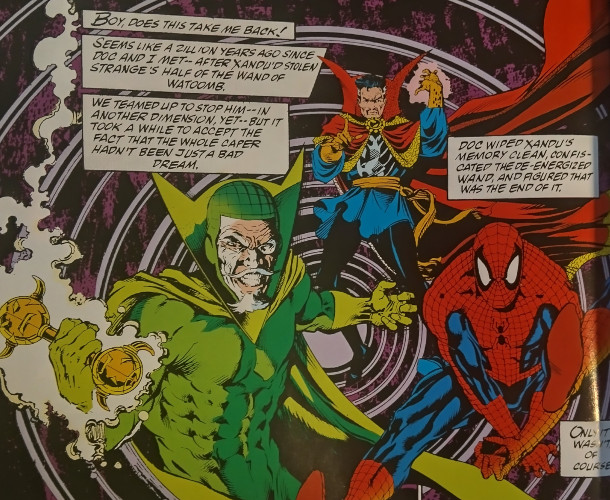
Dusty Death basically picks up here, opening with Spidey saving Melinda from committing suicide and then working with Strange to try and rescue her from demons from the Death Dimension, which Xandu has conquered. Roy Thomas nicely carries on the story in a way that feels like a natural extension from the previous tales—though some of the middle section is used as exposition to detail events from the past three issues, the story never feels bogged down during these moments. The background information reads quite fluidly, serving to pull together the various strands from past tales and tying them together in a way that feels coherent. Thomas doesn't demand that you have read the prior issues, and his masterful command of the exposition calls your attention to the importance of the past. You feel like he's caring for the reader, guiding them through previous plot points, not just to catch you up on the narrative at-hand but to help you really understand what's going on in the graphic novel.
Thomas' writing in general is fairly smooth. I tend to equate him with "older writers" of the early Marvel era, slotting him in with the guys who would write stilted, blocky text that reflected cultural norms of the past and come across as cheesy and over-dramatic. Think Stan "The Man" Lee. I've noted my appreciation for Roy "The Boy" Thomas' writing over Lee's previously, and this story is a decent indication of that maturity. Both Spidey and Doc Strange receive nice inner monologues through text boxes that do get a little wordy at moments but read well for the most part. Spidey is properly humorous, and Doc Strange doesn't spend every other panel screaming "BY THE VISHANTI!" or some other mystical mumbo-jumbo.
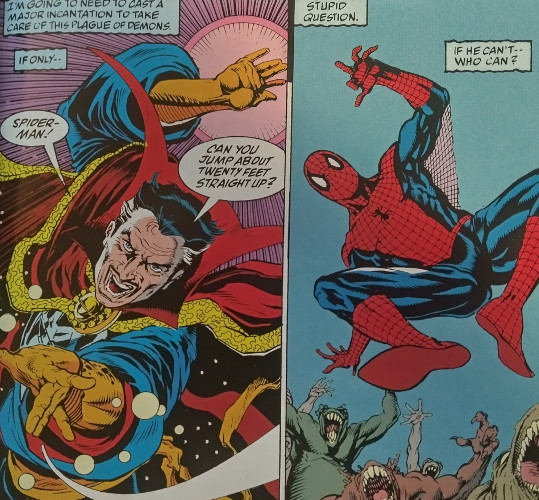
As with other "older writers" like J.M. DeMatteis and Gerry Conway, whose later 80s/90s/early 00s works read better (I would argue) then their earlier writings, Thomas proves a wonderful craftsman when it comes to dialogue and characterization. I was expecting that Stan Lee-esque corniness with the dialogue, meaning I was pleasantly surprised with several of the lines that Thomas weaves throughout the novel; one specific moment sees Spidey commenting on various tremors in the Death Dimension, claiming that "compared to what must be underneath this place, the San Andreas Fault is practically a virtue." Playing on the various meanings of "fault," Thomas deftly cracks a joke that beautifully contrasts the differences between the San Andreas Fault and the Death Dimension. It's a moment worth a chuckle and works much better than that time Lee tried comparing Spidey's webbing to walruses.
The main story itself doesn't add a ton to the already existing Xandu narrative, except to serve as the final chapter(?) in a tale that had been periodically added to for the past 27 years. Thomas throws in whatever magical tropes he can: body-switching, portals to other worlds, spells and charms, bolts of otherworldly energy zipping all over the panels, armies of murderous monsters. Several pieces smack of "If you’ve seen them once, you've seen them all," meaning the narrative ends up feeling a little basic. There's really no single moment that makes you go, "Ah, yes, I will be remembering this story for years to come."
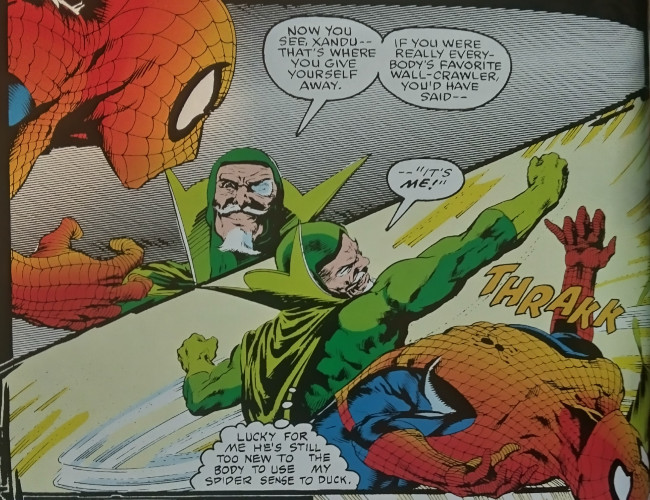
Spidey and Doc Strange have never been the type to exchange quips or barbs, and their team-up here is largely conducted indepdently of each other. While this isn’t necessarily the biggest criticism of the book—I think having Spidey and Doc Strange fighting side-by-side and appropriately depicting their contrasting combat styles is difficult to do, thought not impossible (MTU #21 uses this to great effect in the story’s climax)—it does make the alliance feel just a tad hollow. Unlike Daredevil or the Human Torch (or, heck, even Iron Man or Wolverine, I'd argue), Spidey has few similarities to Strange, as I mentioned above, meaning there are no decent "bonding" moments in this or other stories. Again, their pairing is a weird one, and aside from the Steve Ditko connection, I would argue that the two collide as often as they do because thrusting Spidey into a bizarre magical situation is something writers like tackling. Weird and wondrous as Spidey's world is, his part of the Marvel Universe has always felt more grounded and founded in science and logic. So what happens when you start throwing demon armies and mystical wands at him? The results are often entertaining, but still occasionally come across as off-putting. You're not really left with a "Spidey and Doc Strange understand each other better" feeling by story’s end; like other Spidey/Strange team-ups, the two sort of just go on their merry ways once the conflict is resolved.
There is room, I would argue, for such connections to be created between the two men. Both were involved in life-altering accidents; both struggled with the guilt associated with their particular situations; both can be driven by believing themselves at fault for the world's troubles...which is sometimes true. Other writers have done well to tether Stephen Strange's origin to his current stance on heroics as much as Spidey's origin has always been core to his activities. Thomas makes no such correlations here, a missed opportunity for growth, I would argue.
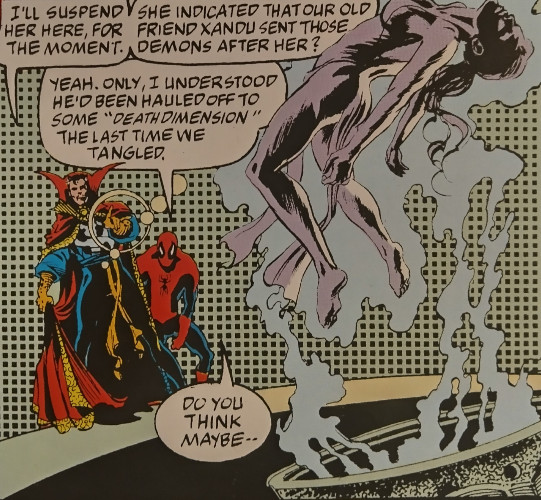
That's not to say this is a bad story. I remember reading the ASM Annual for the first time several years ago; imagine my surprise when, back in 2016, I read Marvel Team-Up #21 and saw that Len Wein decided to carry on the seemingly one-and-done Xandu/Wand of Watoomb story. And then, a few years ago, I was even more astonished to find that not one, but TWO sequel stories were written as follow-ups to those issues. "Whatever happened to Xandu?" was never a question that materialized in my head until I found a volume containing The Way to Dusty Death. But then the continuity-nut of a comic geek that I am had to, absolutely had to, see where this story headed.
Some stories don't deserve sequels (heck, some stories shouldn't receive sequels), and some characters don't deserve additional appearances. Xandu was never a major antagonist for either Spidey or Strange, but considering he was a narrative thread that pulled the two heroes together a handful of times makes him a bit more important than he appears to be. And, again, all four issues contain an overall narrative that builds and becomes nicely resolved by the time this graphic novel reaches the final page. I thrill most times a writer brings back a seemingly forgotten plot point or character or takes the time to expand upon a concept you never believed would be revisited. So although the story itself isn't overly memorable and can feel a little cliché or repetitive, The Way to Dusty Death is a nice exercise in the continual methods of storytelling comics excel at and fluidly displays how writers can expand upon universes and storylines created decades ago, showing new dimensions to places you thought were already explored.